_-_Palais_Liechtenstein_(F%C3%BCrstengasse).JPG.webp) Front of Liechtenstein Garden Palace | |
| Established | 29 March 2004 |
|---|---|
| Location | Liechtenstein Garden Palace Fürstengasse 1, Vienna, Austria |
| Type | Art museum |
| Owner | Prince of Liechtenstein Foundation |
| Website | liechtensteincollections.at |
The Liechtenstein Museum is a private art museum in Vienna, Austria. It contains much of the art collection of its owners, the Princely Family of Liechtenstein, rulers of the principality of Liechtenstein. It includes important European works of art, forming one of the world's leading private art collections. Its highlight used to be Leonardo da Vinci's portrait of Ginevra de' Benci, which was acquired in 1967 by the National Gallery of Art in Washington, D.C.[1]
The museum, which was originally open to the public from the early 19th century until the Anschluss of 1938, had various locations, including the Liechtenstein Garden Palace (Gartenpalais) at Fürstengasse 1 in Vienna's 9th District (Alsergrund), and the Liechtenstein City Palace (Stadtpalais) at Bankgasse 9 in Vienna's 1st District (Innere Stadt). The museum was reopened on 29 March 2004 in the Garden Palace, but after battling with low visitor numbers, it was closed for regular visiting by the public in November 2011. According to the official website of the Garden Palace, "the highlights of the princely collections can be viewed exclusively as part of an event package or a pre-booked guided tour".[2]
Objects from the collection have been sent on touring exhibitions to museums in other countries, especially the United States. In particular, displays are regularly mounted at the Kunstmuseum Liechtenstein in Vaduz, which is otherwise a gallery for a modern art collection donated to the principality of Liechtenstein by the ruling family. Other works from the collection fill the palaces and residences of the Princely Family in Liechtenstein and Austria.
A catalogue of the artists (with short biographies) featured in the gallery at the time of Prince Joseph Wenzel was compiled by Vicenzo Fanti in 1767.[3]
Liechtenstein Garden Palace
_060.jpg.webp)
The Gartenpalais was built by Prince Johann Adam Andreas von Liechtenstein, who commissioned its design and construction from Domenico Egidio Rossi; the shell was finished in 1700.[4] Painted décor in the Gartenpalais was contributed by Marcantonio Franceschini, Antonio Bellucci, Andrea Pozzo and Johann Michael Rottmayr. Sculpture came from Giovanni Giuliani and his studio, and stucco from the stuccator Santino Bussi.
Originally there was a garden belvedere on the north side of the park, which was replaced from 1873 to 1875 by a garden palace for the prince's widow Franziska built by Heinrich Ferstel. This building later served as a residence for other family members and is now rented out, while the Prince resides in the Liechtenstein City Palace when he visits Vienna.
 Park-side facade
Park-side facade Park
Park.JPG.webp) Palace of the Princess Dowager at the opposite side of the park
Palace of the Princess Dowager at the opposite side of the park
Artworks (selection)
.jpg.webp) Raphael, Portrait of a Man
Raphael, Portrait of a Man Giulio Romano, St. John the Baptist in the Wilderness
Giulio Romano, St. John the Baptist in the Wilderness_1631_LIECHTENSTEIN_COLLECTION_PRINCIERE.jpg.webp) Valentin de Boulogne, A Musical Company with a Fortune-Teller ("Reunion with a Gypsy")
Valentin de Boulogne, A Musical Company with a Fortune-Teller ("Reunion with a Gypsy")

 Rubens, Lamentation of Christ
Rubens, Lamentation of Christ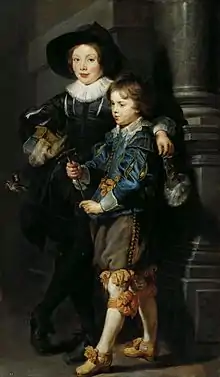 Rubens, Portrait of his sons Albert and Nicolaas
Rubens, Portrait of his sons Albert and Nicolaas Rubens, Portrait of his daughter Clara
Rubens, Portrait of his daughter Clara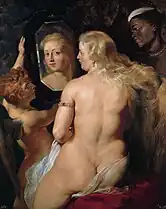 Rubens, Venus making her toilet
Rubens, Venus making her toilet Frans Hals, Portrait of a man
Frans Hals, Portrait of a man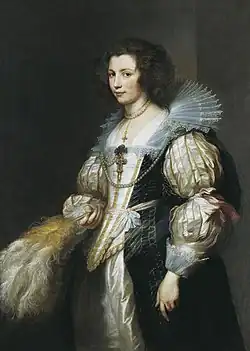 Van Dyck, Portrait Marie Louise of Taxis
Van Dyck, Portrait Marie Louise of Taxis
 Gerard Dou, Violinist
Gerard Dou, Violinist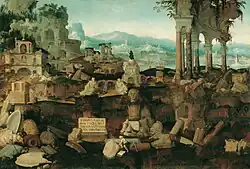 Herman Posthumus, Landscape with ruins
Herman Posthumus, Landscape with ruins Jan Miense Molenaer, 1636-37, The king drinks (Twelfth Night festivities)
Jan Miense Molenaer, 1636-37, The king drinks (Twelfth Night festivities)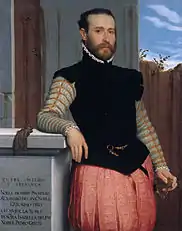 Giovanni Battista Moroni, Prospero Alessandri
Giovanni Battista Moroni, Prospero Alessandri Mansueti, The Taking of St. Marc
Mansueti, The Taking of St. Marc Sebastiano Ricci, Rape of the Sabine Women
Sebastiano Ricci, Rape of the Sabine Women Salviati, Portrait of a young man
Salviati, Portrait of a young man Friedrich von Amerling, Girl with a straw hat
Friedrich von Amerling, Girl with a straw hat Golden carriage of Joseph Wenzel I. of Liechtenstein (1738)
Golden carriage of Joseph Wenzel I. of Liechtenstein (1738)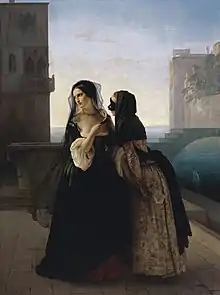
Notes
- ↑ Wheelock, Arthur K. Jr. (2021). "In Pursuit of Masterpieces: The National Gallery of Art's Acquisitions from the Prince of Liechtenstein". Artibus et Historiae. 42 (83): 313–332.
- ↑ "Guided Tours - Palais Liechtenstein". palaisliechtenstein.com.
- ↑ delle vite de Pittori, Scultori, e d'altri Artefici le di cui famose opere formano la prescrita celebre galleria di sua altezza Giuseppe Wenceslao Principe Regnate della Casa di Lichtenstein
- ↑ The history of the construction is in Günter Passavant, Studien über Domenico Egidio Rossi und seine bauküstlerische Tätigheit innerhalb des süddeutschen und österreichischen Barok(Karlsruhe: Braun) 1967:109-23.
External links
- Official website
- Liechtenstein Garden Palace webpage
- Firearms from the collections of the Prince of Liechtenstein, an exhibition catalog from The Metropolitan Museum of Art (fully available online as PDF), which contains material from the Liechtenstein Museum
- Peter Paul Rubens: the Decius Mus cycle, an exhibition catalog from The Metropolitan Museum of Art (fully available online as PDF), which focuses on this work from the Liechtenstein Museum